Thursday, March 4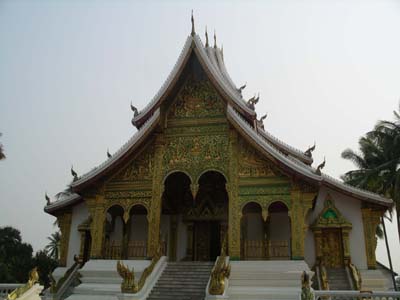
Steve: We began today with a short visit to the Royal Palace, which since 1975 has been a museum but originally served as the home for Laos' kings from 1904 until the death of the last king in 1959. Interestingly, the king had a son but he disappeared in 1959 and was never officially crowned (no one knows whether he's alive today). The museum contains the Phra Bang, supposedly made in 1356 and presented to the first king of Laos. There are many rumors about whether this is actually the original Phra Bang, including one that says it was moved to Moscow after the Communist takeover here in 1975. Others believe that the solid gold statue is stashed in Laos' central bank. The Royal Palace contains various artifacts from the lives of the members of Laos' royal family, including gifts from the United States (several keys to cities, plus a Laos flag that was taken to the moon in 1969).
 Our
next stop was at a silk village. Here we saw silk worms, the cocoons that
produce the silk, and the natural dyes that are used to color the thread.
David and Katie particularly enjoyed playing with and feeding the worms (they
only eat mulberry leaves), and Katie wanted to take one
Our
next stop was at a silk village. Here we saw silk worms, the cocoons that
produce the silk, and the natural dyes that are used to color the thread.
David and Katie particularly enjoyed playing with and feeding the worms (they
only eat mulberry leaves), and Katie wanted to take one 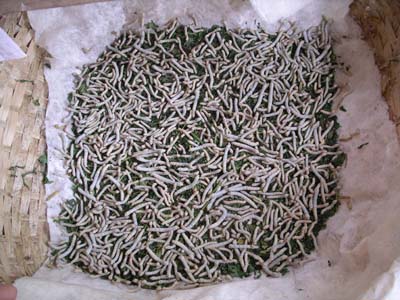 home
as a pet ("we haven't had a pet in a long time," she said…).
We then watched several women who were hand-weaving silk scarves. The process
to produce the intricate designs is amazingly labor-intensive, but the finished
products are very beautiful. Katie and Paula purchased several scarves, including
one that was still being woven (this was Katie's favorite, and someone
home
as a pet ("we haven't had a pet in a long time," she said…).
We then watched several women who were hand-weaving silk scarves. The process
to produce the intricate designs is amazingly labor-intensive, but the finished
products are very beautiful. Katie and Paula purchased several scarves, including
one that was still being woven (this was Katie's favorite, and someone 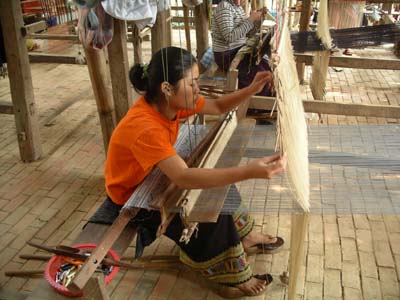 will
be bringing it to our hotel when it's completed tomorrow).
will
be bringing it to our hotel when it's completed tomorrow).
We then left Luang Prabang and drove along dirt roads about an hour toward
the waterfalls at Kuang Si. This was our first opportunity to explore the
mountainous countryside of Laos, much of which is now barren as it's the dry
season. It was also possible to see more of th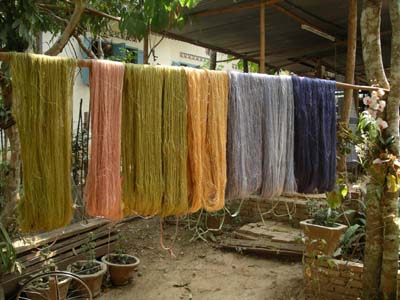 e
impact of the burning which is happening here now - large patches of cleared
land appear along almost all of the mountains. The roads we drove on today
are very typical of most in Laos - they're unpaved and often bumpy. Because
of this, we've noticed that everyone here drives very slowly. This happens
to perfectly match the pace of almost everything else in Laos - Nit told us
that the people joke that PDR, which stands for "People's Democratic
Republic" really stands for "Please Don't Rush.
e
impact of the burning which is happening here now - large patches of cleared
land appear along almost all of the mountains. The roads we drove on today
are very typical of most in Laos - they're unpaved and often bumpy. Because
of this, we've noticed that everyone here drives very slowly. This happens
to perfectly match the pace of almost everything else in Laos - Nit told us
that the people joke that PDR, which stands for "People's Democratic
Republic" really stands for "Please Don't Rush.
Along the way to Kuang Si, we had interesting conversations with Nit about life in Laos. We started by talking more about the economic situation here. We learned that the kip had been valued at $1.00 when it was introduced in 1979. By 1990 the exchange rate was 2,000 kip/dollar, in 1993 it was 3,000 kip/dollar and now it's 10,000 kip/dollar. This has obviously made things very difficult for people here. Nit said that the average salary for Luang Prabang residents is $150-200 per month, which typically must be supplemented by various farming activities in order to allow people to make enough money. In the countryside, where the large majority of people live, income levels are much lower which is what brings the country average down to $120 per year.
People living in Luang Prabang typically have their own house with a refrigerator and a television. Those who can afford it have motorbikes and washing machines. Other than clothes and necessities for cooking, that represents most of the material possessions for the people here. For people who make enough to have excess cash, it is generally spent on parties and other social events. In the countryside villages, most people have much less (even television is limited to the relatively small number of villages with electricity). We got a good sense of life outside the city today when we visited villages (more on that later).
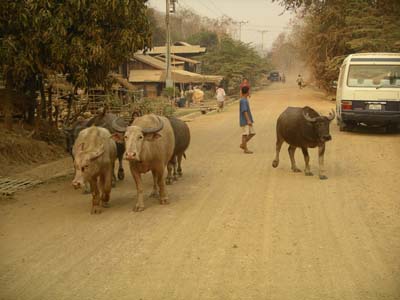 Nit
discussed the role that the government must play in balancing the need for
change with its concern over allowing change to occur too quickly. This has
manifested itself in several ways, including the policies regarding the paving
of roads, introduction of machines to assist with farming, and the use of
homes as guest houses for tourists. A primary concern is introducing change
which could result in people becoming lazy.
Nit
discussed the role that the government must play in balancing the need for
change with its concern over allowing change to occur too quickly. This has
manifested itself in several ways, including the policies regarding the paving
of roads, introduction of machines to assist with farming, and the use of
homes as guest houses for tourists. A primary concern is introducing change
which could result in people becoming lazy.
Nit said that until recently, the government warned locals regarding foreigners, and provided strict guidance regarding what could be said. Specifically excluded were discussions about politics, and violation of this policy would result in people being thrown in jail. Apparently, these regulations have all been relaxed significantly in recent years.
Nit asked us about what snow felt like, since she's never seen snow. Like most other Laotians, she has also never seen an ocean. Other than the small number of people who can afford trips to China (an 8-hour bus ride) or 2-day boat trips to Thailand, most residents have not traveled outside of Laos.
We passed a radio broadcasting station, which led to a discussion about Lao TV and radio. These are both controlled by the government, and most people who have television or radio prefer to tap into Thai broadcasting. The Lao government now allows this to happen (they probably have no choice).
Medical care facilities are very limited in Laos, which explains the low life expectancy (54 years). Nit also estimated that 1 of every 3 children born in the countryside die before they reach their teenage years (that's based on her experience in knowing families who live in the villages). In Luang Prabang, there's an older hospital that provides free care, but people must wait excessively long to receive treatment. A new hospital has been built, but the government charges 20,000 kip ($2.00) per night. That's prohibitively expensive for most people. There is also a shortage of doctors, because the government salaries for physicians are only $40/month. Nit said that people who do office work can often earn 2-3 times this amount. Medical insurance is not available for people in Laos.
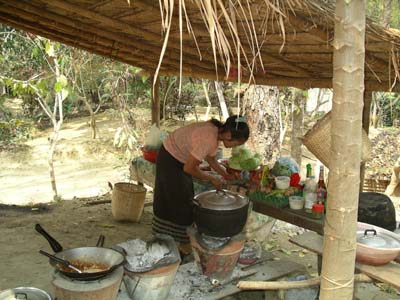 After
arriving at the Kuang Si falls, we had lunch in one of the small outdoor restaurants
that line the path up to the falls. Here we enjoyed a wonderful meal of traditional
Lao noodle soup, accompanied by rice. Our food was all prepared in an outdoor
kitchen by the woman who took our order, and we watched her cut and slice
fresh vegetables that were cooked into our food. We also took a picture of
the menu to show the prices for food here. Lunch for the 5 of us (including
Nit) came to a total of 63,000 kip, or $6.30. This included 2 Cokes which
represented $2 of the total bill.
After
arriving at the Kuang Si falls, we had lunch in one of the small outdoor restaurants
that line the path up to the falls. Here we enjoyed a wonderful meal of traditional
Lao noodle soup, accompanied by rice. Our food was all prepared in an outdoor
kitchen by the woman who took our order, and we watched her cut and slice
fresh vegetables that were cooked into our food. We also took a picture of
the menu to show the prices for food here. Lunch for the 5 of us (including
Nit) came to a total of 63,000 kip, or $6.30. This included 2 Cokes which
represented $2 of the total bill.
The Kuang Si waterfalls are very beautiful, although during the dry season
there's a much smaller amount of water. The pools under 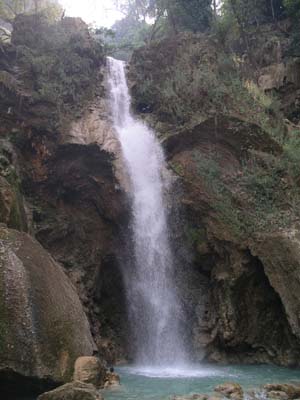 the falls are particularly peaceful, and are surrounded by bamboo trees and
wild flowers. There are also large numbers of colorful butterflies here. These
falls represent one of two main destinations for visitors who come to Luang
Prabang (the other being the Pak Ou caves that we'll visit tomorrow). At one
point, a Mhung village above the falls built a dam that stopped the falls,
but the govern
the falls are particularly peaceful, and are surrounded by bamboo trees and
wild flowers. There are also large numbers of colorful butterflies here. These
falls represent one of two main destinations for visitors who come to Luang
Prabang (the other being the Pak Ou caves that we'll visit tomorrow). At one
point, a Mhung village above the falls built a dam that stopped the falls,
but the govern ment
moved the village so that the falls could continue, since they serve as an
important tourist attraction.
ment
moved the village so that the falls could continue, since they serve as an
important tourist attraction.
After we left Kuang Si, we stopped in three different villages. The first
village, Banou, is a typical lowlander village. The lowlanders represent 66%
of the population of Laos, the largest of the 3 ethnic groups. This village
primarily produces blankets, but none were being made today because of the
heat. It didn't feel too hot to us, but we assume that the production stops
as the hot season nears (it starts getting very hot in 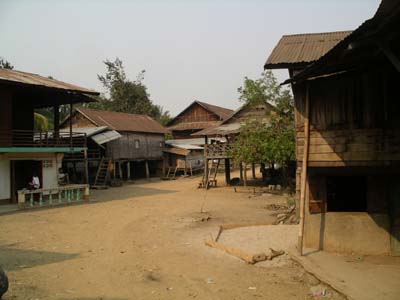 April).
Seaweed from the Mekong is also collected, dried, seasoned and fried here.
April).
Seaweed from the Mekong is also collected, dried, seasoned and fried here.
We spoke with a group of women who were sitting and talking (Nit said 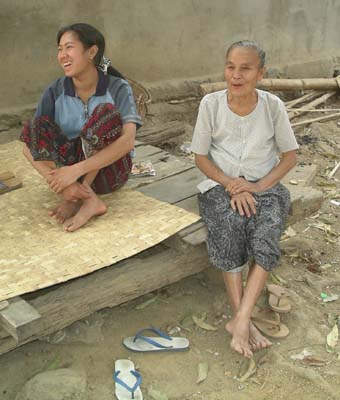 that
this is basically all they have to do during the days). As is the case everywhere
here, the people were all very impressed with the height of David and Katie,
especially when they learned their ages.
that
this is basically all they have to do during the days). As is the case everywhere
here, the people were all very impressed with the height of David and Katie,
especially when they learned their ages.
This village has no electricity, and people live with a minimum of material
possessions. They farm their own food by the river, but are too far from Luang
Prabang to grow food or wood for sale. Most people are married by age 14 or
15, and the women told us that the average family has 4-5 children (accounting
for the 2-3 other children 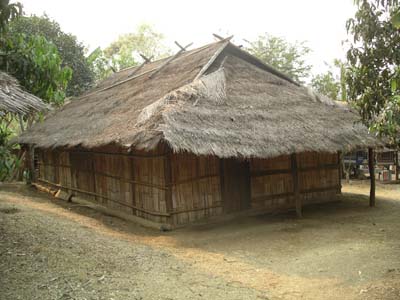 who
are probably born but die at young ages, usually from illness). As we left
this village, Nit told us that it is very typical of most of the villages
in Laos.
who
are probably born but die at young ages, usually from illness). As we left
this village, Nit told us that it is very typical of most of the villages
in Laos.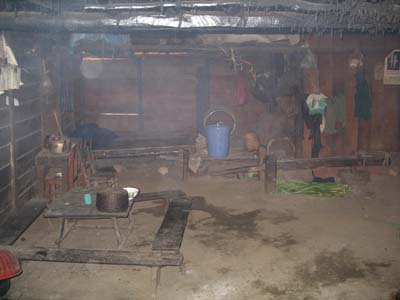
Our next stop was at a highlander, or Mhung village (highlanders represent
10% of Laos' population). Mhung villages typically exist in the mountains,
but this particular village was relocated from the top of the waterfalls because
they had built a dam that prevented the water from flowing. The Mhung homes
have no windows, a style that results from the desire of the men to smoke
opium in a dark surrounding. Historically, Mhung men grow and smoke their
own opium while the women work in the fields. The men have their own dark
rooms in corners of the homes where they sit and smoke during the day. The
government allows this to 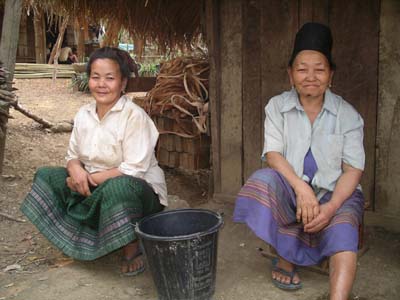 continue,
but encourages the men to stop and provides job training programs in an effort
to support them.
continue,
but encourages the men to stop and provides job training programs in an effort
to support them.
We were invited into one of the Mhung homes, and we found it hard to understand
how people can live this way. The home was totally dark inside, and extremely
smoky due to the 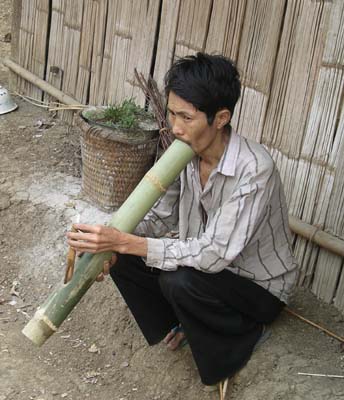 cooking
fire that burned in the center. We learned that 9 people live here, sleeping
on bamboo beds. Mhung men have up to 3 wives, and 2 wives live in this particular
home, side-by-side. We spoke with one of the wives - she's the one on the
right in the picture above. She didn't know how old she was, and said that
she couldn't count so she didn't know how many children she had.
cooking
fire that burned in the center. We learned that 9 people live here, sleeping
on bamboo beds. Mhung men have up to 3 wives, and 2 wives live in this particular
home, side-by-side. We spoke with one of the wives - she's the one on the
right in the picture above. She didn't know how old she was, and said that
she couldn't count so she didn't know how many children she had.
Despite the condition of the home, which to us seemed unlivable, the people living here appear happy. They smiled and laughed as Nit translated a conversation between us. This made us again think about what's really required for people to live a satisfying life.
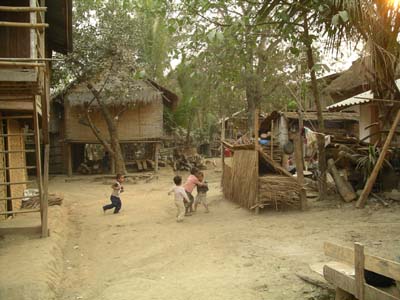 After
leaving the home, we met two men in the village. One of these men demonstrated
how he uses a trap to catch rats that are eaten by the villagers. He said
that he used to smoke opium, but had been able to stop. The other man (pictured
above) was very thin and appeared unhealthy and said he still smokes the opium.
He demonstrated how he uses a water-pipe to smoke (although when we saw him
he was just smoking tobacco). This was actually a very sad sight, and it made
us all somewhat uncomfortable.
After
leaving the home, we met two men in the village. One of these men demonstrated
how he uses a trap to catch rats that are eaten by the villagers. He said
that he used to smoke opium, but had been able to stop. The other man (pictured
above) was very thin and appeared unhealthy and said he still smokes the opium.
He demonstrated how he uses a water-pipe to smoke (although when we saw him
he was just smoking tobacco). This was actually a very sad sight, and it made
us all somewhat uncomfortable.
Our final stop was at a midlander village. The midlanders live in homes that are very similar to the lowlanders, but they speak a different language (one that Nit can't understand) and have darker skin. This village is fortunate to be located near Luang Prabang, and has its own electricity. They can also cut and transport firewood and vegetables to town, giving them a good source of income. We met and spoke with several young women in the village. One of these women was 18 years old, and was carrying her 2 ½ year old daughter in her arms.
Our experiences visiting these villages were very educational for us all. Of Laos' 5.6 million people, 80% live in the countryside in villages very similar to those we saw today. Tomorrow we'll be taking a boat on the Mekong River to visit the Pak Ou Caves, and hope to visit some more villages along the way.
